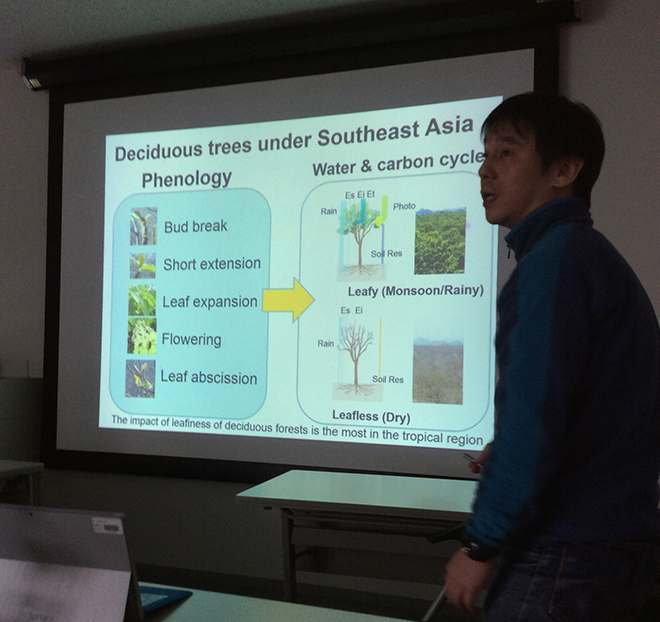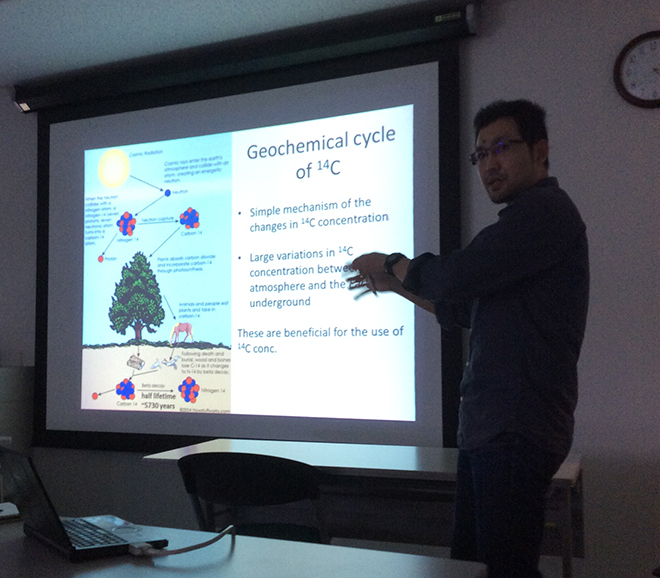- 【Members ONLY】
Presentation material

Changes in teak growth phenology results in heavy defoliation in northern Thailand
December 21, 2015 big meeting room, 5th floor, IT bldg, Yokohama campus
| 13:30 -- 14:00 | Administrative issues(Director Rikie Suzuki) |
| Interdisciplinary seminars | |
|---|---|
| 14:00 -- 15:00 | Speaker 1: Dr. Katsunori Tanaka Title: Changes in teak growth phenology results in heavy defoliation in northern Thailand |
| 15:00 -- 15:20 | break |
| 15:20 -- 16:30 | Speaker 2: Dr. Takuma Miyakawa Title: Radiocarbon analysis of aerosols toward understanding the origin of organic and black carbons |
The goal of study conducted at the Mae Mo teak plantation in northern Thailand was to clarify the trigger of early leaf flush and the subsequent pattern of leaf growth. Daily radiative transmittance from above the canopy, which decreases exponentially with increasing leaf area index (LAI) and soil moistures, were measured in a teak plantation in northern Thailand from January through August in 2001-2012. We found the trigger of leaf flush is increased soil moisture around root zone and that the subsequent leaf growth becomes slower with earlier leaf flush, implying that the slower leaf growth might be related to shorter day length. These results should be applied to a dynamic global vegetation model for one of tropical deciduous trees. We also found the early leaf flush results in heavy defoliation by teak pest. The leaf growth period when trees with tender leaves were exposed was extended in the early leaf flush, which may result in heavy defoliation.
Hyblaea puera (Cramer 1777) appeared to be primarily responsible for the defoliation, since pupal exuviae were frequently found after periods of defoliation. In 2015, our photographic data sets directly prove that early leaf flush results in teak defoliation by H. puera. We expected that the early leaf flush may extend photosynthetic period of the forest and may contribute to carbon gain. However, our result implied that it likely cancel the effect of extension of photosynthetic period on carbon gain or decrease carbon gain in years when heavy defoliation occurred.


Carbonaceous materials are a major component of the fine aerosol. They originate from different anthropogenic and biogenic sources and are released as primary particles or are formed as secondary organic aerosol (SOA) from volatile organic compounds (VOC) as gaseous precursors (Jacobson et al., 2000). Radiocarbon (14C) analysis provide a unique possibility for unambiguous source apportionment of carbonaceous aerosols (Currie, 2000). In this seminar, the 14C analysis of aerosols will be briefly reviewed. I am also going to report the recent analysis results from our observations in East Asia.
